Oct. 16, 2022, was the day I broke my first bone.
I wish I could tell you this cool story about how I broke my left foot, but to be honest, I tripped down the stairs because, well, I’m clumsy.
One week before the incident, I moved from Boulder, Colorado, to Ottawa, Ontario, Canada. I left CrossFit Roots — my CrossFit community of seven years — in search of a new gym to call home. Just one day before I was supposed to try out my first class at CrossFit NCR, I found myself at the bottom of my staircase with a profusely swollen foot.
As CrossFit founder Greg Glassman said, “Injury, like illness, is an ineluctable fact of life.”
Although I was told I would be in a walking boot for the next six weeks, I refused to isolate myself for that long. Ultimately, CrossFit NCR helped me get back on my feet.
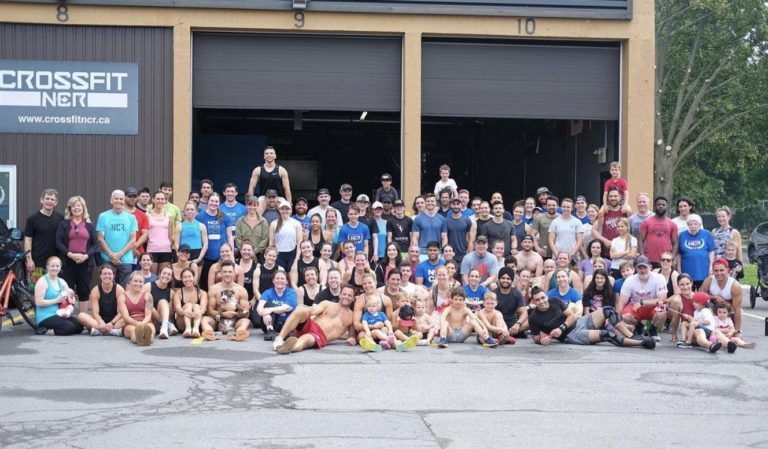
It might seem intimidating to walk into a new CrossFit gym — or even a familiar gym — and tell the coach you will need specialized scaling options for the next six weeks. However, I attribute my fast recovery and emotional well-being to CrossFit NCR. The coaches, community, and staff supported me as I navigated not only a new city but also a new country and a new injury.
If you find yourself in a similar situation, injured and itching to keep your routine, stay active, find a support system, and don’t skip the gym.
Here’s why you should still do CrossFit, even while rehabbing an injury, and examples of scaling options to ensure a safe and speedy recovery.
The Benefits of CrossFit During Recovery
The health benefits of CrossFit — such as increased strength, endurance, flexibility, balance, and power — still extend to athletes who are recovering from an injury. If you break your foot, you still have three other working ligaments to train.
Alongside the overall improvements in your health, staying active while rehabbing an injury can also aid in healing tissues.
“If you can keep blood flowing, blood brings oxygen to healing tissues. And that’s beneficial by itself,” Orthopedic Surgeon Dr. Sean Rockett (CF-L2) says. “As long as you’re checking with your doctor about your injury, then I think it’s perfectly fine (to do CrossFit).”
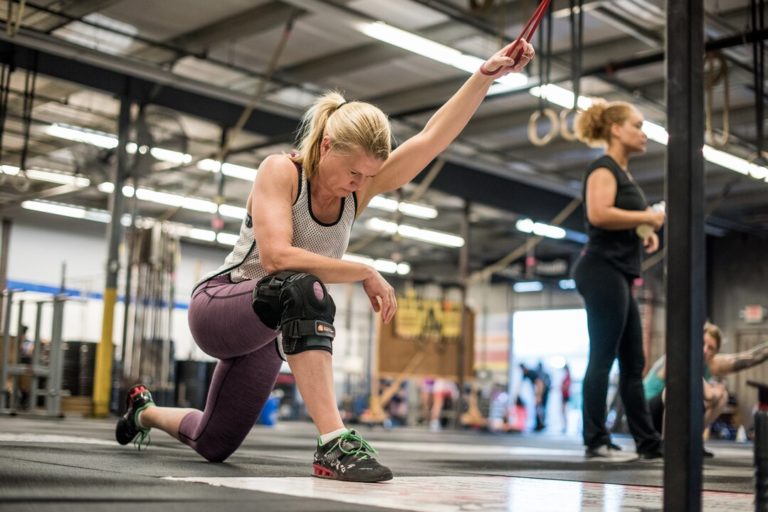
It’s also important to keep using the uninjured parts of your body during recovery so you don’t lose the ability to use those muscles.
According to an article by Harvard Medical School, “After an injury, illness, or any prolonged period of inactivity, muscle loss can occur faster, leading to muscle atrophy… . A study in the Journal of Rehabilitation Medicine found that older men who did eight weeks of strength training lost about 25% of their muscle gains after they stopped training for two weeks.”
When my boot came off in December 2022, I was able to ease back into training. In February, I participated in the 2023 CrossFit Open, which included shuttle runs. By May, I was running a 5K.
Besides the health benefits, continuing to show up to your CrossFit gym while rehabbing an injury has many mental health benefits.
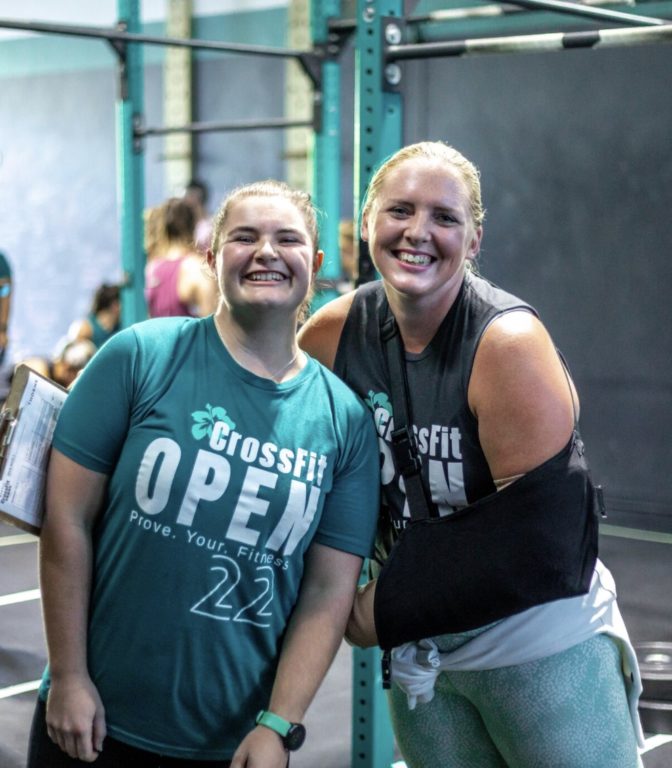
When an athlete sustains an injury, it can trigger an emotional response of anger, sadness, and frustration, which can ultimately lead to social isolation.
“There is a direct association between loneliness, coronary heart disease, and stroke mortality,” Brittney Saline wrote in the article Loneliness Is Making You Sick. CrossFit Can Help. “ Data also shows a connection between social isolation and allostatic load, or damage to the body resulting from chronic stress, as indicated by inflammation and neuroendocrine and cardiovascular markers.”
By disrupting your routine and isolating yourself from your community, it can actually hurt your body even more.
CrossFit promotes a culture of humility, belonging, and camaraderie. Even if you aren’t able to perform the movements to the same level you could before your injury, through scaling you can still participate in the workout alongside your friends.
When I moved to Canada, I knew almost no one. CrossFit NCR became an essential support system throughout my recovery. The coaches consistently checked in with me about my progress, and my classmates would help carry my equipment and ask if I needed assistance to my car. Most importantly, the community made me smile through a difficult time in my life.
I was reminded every day that I truly wasn’t alone in my recovery.
That’s how I was able to get out of bed each morning for six weeks. I knew I would see my favorite people at 9:30 a.m., get a good workout in, and come home feeling productive and energized for the day.
Tips to Consider When Returning to CrossFit
If you become injured, here are a few tips to consider when returning to CrossFit.
Talk to Your Doctor
It’s important to talk to your doctor before returning to CrossFit to understand if you are cleared to go back to the gym and what movements are strictly off-limits. Don’t just ask your doctor, “Can I do CrossFit?” because some may not understand what that means. Ask them what kind of movements in the gym they would recommend staying away from. Give some examples such as, “I would like to carry a weight in my other arm. When is that appropriate?” or “Can I bench press with my foot injury?”
Ask your doctor if they would be willing to have an open line of communication with your CrossFit coach to ensure they are both on the same page throughout your recovery.
Create a Plan With Your Coach
The next person you need to confide in after your doctor is your CrossFit coach. Take some time before class to discuss your injury and what your doctor has cleared you to do, and create a plan to set parameters and scaling options.
CrossFit coaches go through training on how to scale CrossFit workouts in the Level 1 and Level 2 Certificate Courses and in the CrossFit Certification Courses. For more education, coaches can also take the Scaling Course.
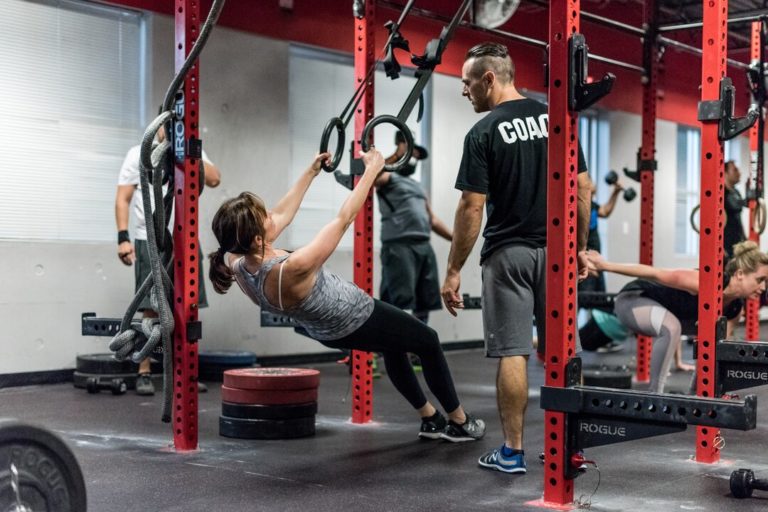
Pain Is Your Guide
While you are rehabbing your injury and even after you have healed, always use pain as your guide. If you feel pain in your injured limb, you’re doing too much.
Seminar Staff Trainer Michele Mootz (CF-L4) says, “You should be pain-free for about seven to 10 days given any movement before you start increasing any other volume, weight, or intensity.”
Be Patient
“Recovery needs to be a linear, long progression. This is not going to be an elliptical progression,” Rockett says.
You may be itching to get back on the high rings or to max out your clean and jerk, but you need to be patient with your recovery. It’s better to come back after you healed and say, “I feel great,” then say, “I PR’d my clean but I feel horrible.”
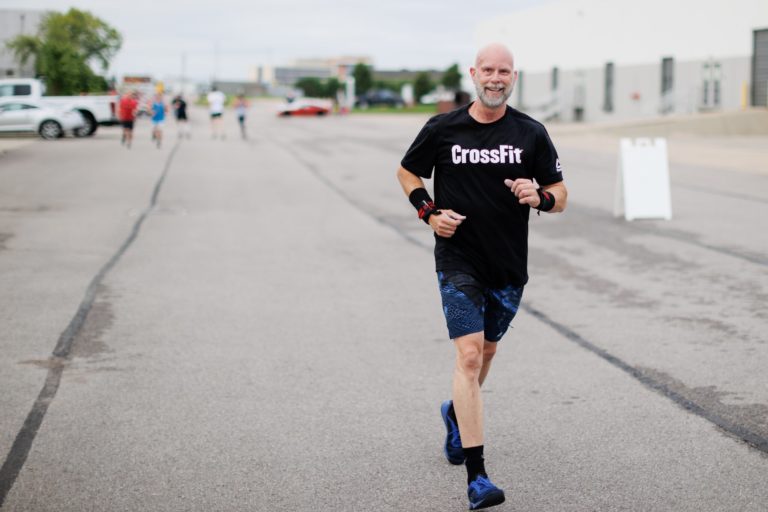
CrossFit Cornerstone | The Michael Patrick Studio
Focus on the Other 23 Hours of the Day
The other 23 hours of the day after the gym is just as important to your recovery. Mootz says to get plenty of rest, eat healthy, and avoid stressors as much as you can. An injury is already a huge stress on your body so you need to focus on taking care of yourself.
How to Scale
“The essence of our approach to working wounded is to divert the focus and purpose of the athlete’s workout away from the injured limb. We want the athlete to work with intensity, variance, and functionality (just not with the injured limb),” Glassman said in the article, “Working Wounded.”
Scaling will differ for everyone depending on experience level and type of injury.
As a relatively average CrossFit athlete, I had to scale back on intensity and focus on technique, while modifying any weight-bearing movements on my foot.
For six-time CrossFit Games athlete Bethany Flores dealing with back pain, scaling might look a bit different.
Regardless of experience, your health comes first. Focus on moving your body while promoting the healing of your injury.
“There’s always going to be resistance in our minds and our bodies to do the things that we know we need to do as far as scaling,” Flores said on the “More Than Fitness” podcast. “It takes a stronger athlete to be like, ‘You know what? I can make changes for my body specifically.’”
When choosing a scaling option, you need to understand what movements will affect your injury and modify them. For example, here are some scaling options for an athlete with a knee injury.
Since I was dealing with a broken foot, my scaling options focused on avoiding strain on my foot while still trying to achieve the attended stimulus during the workout.
Here are a few examples of scaling options for a foot injury from Mootz:
Cleans and Snatches
Use a dumbbell to perform cleans and snatches while seated on a bench or a box.
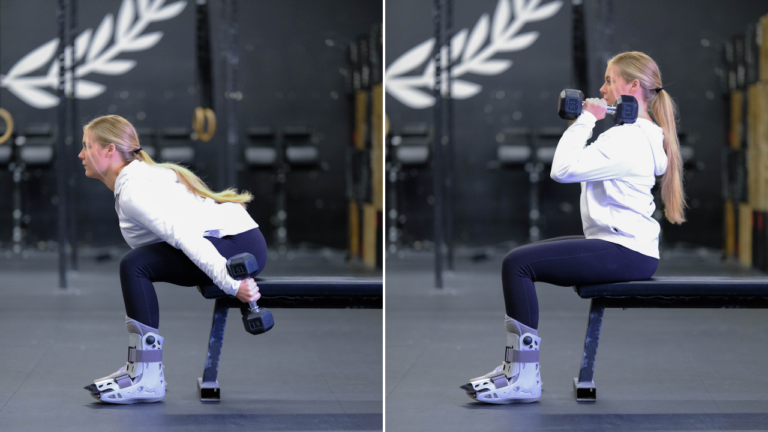
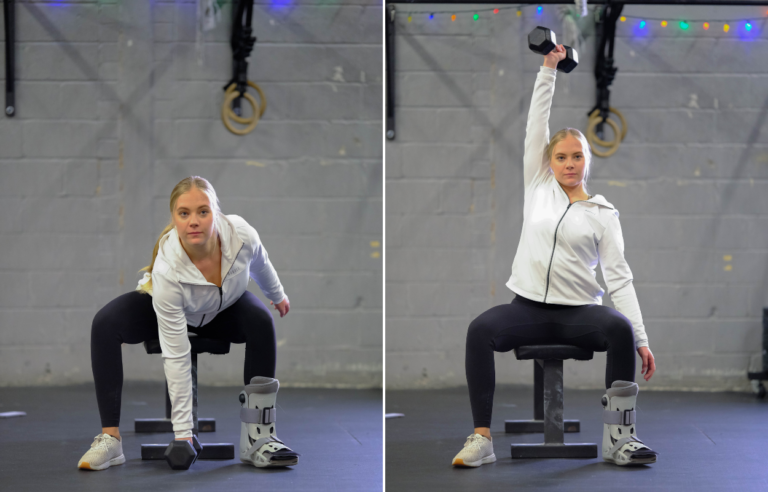
Photos by Abbey Nemeth
Squats
Squat to a high box or hold onto a bar to take pressure off your foot while you squat.
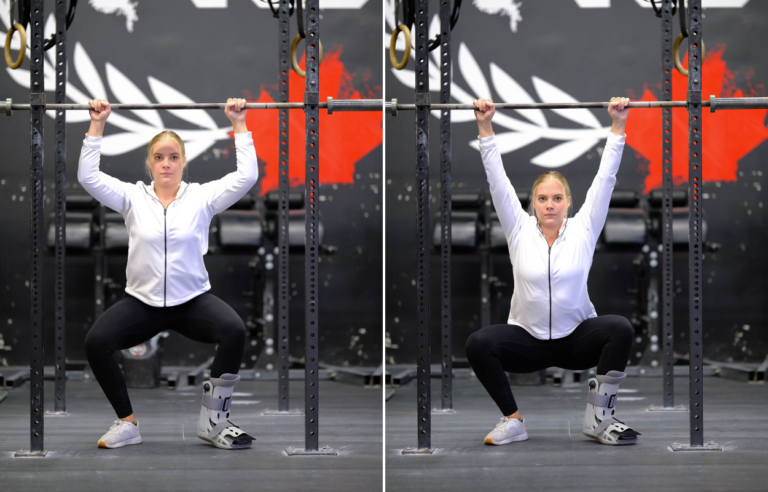
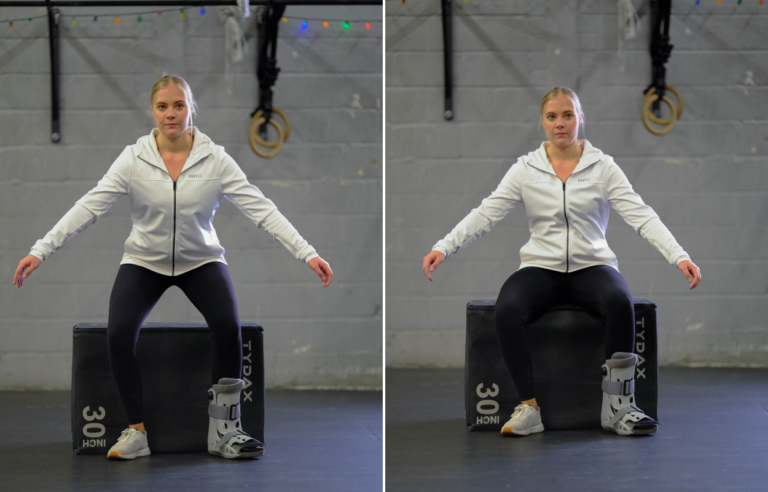
Photos by Abbey Nemeth
Box Jumps
Supplement box jumps with a low step-up.
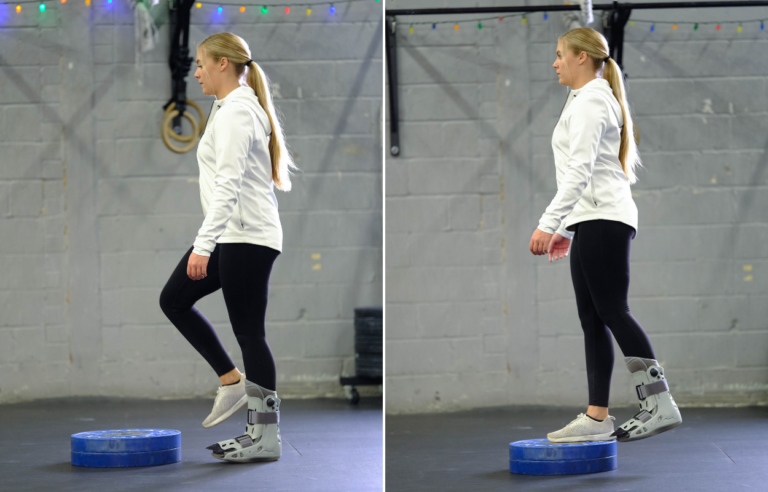
Photos by Abbey Nemeth
Running/Double-Unders
Running, double-unders, or any movement that puts a lot of repeated pressure on the foot can be supplemented with the ski erg or a bike with your injured foot resting on a peg.
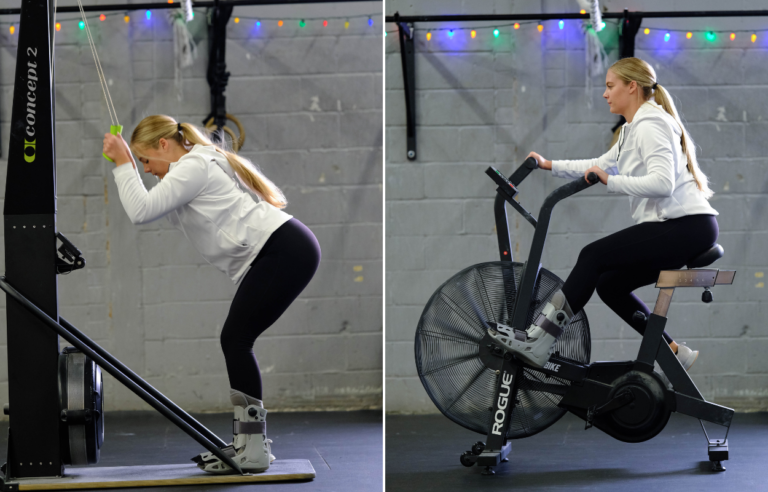
Photos by Abbey Nemeth
Wall-Ball Shots
Perform wall-ball shots by standing from a box instead of squatting or from a seated position.
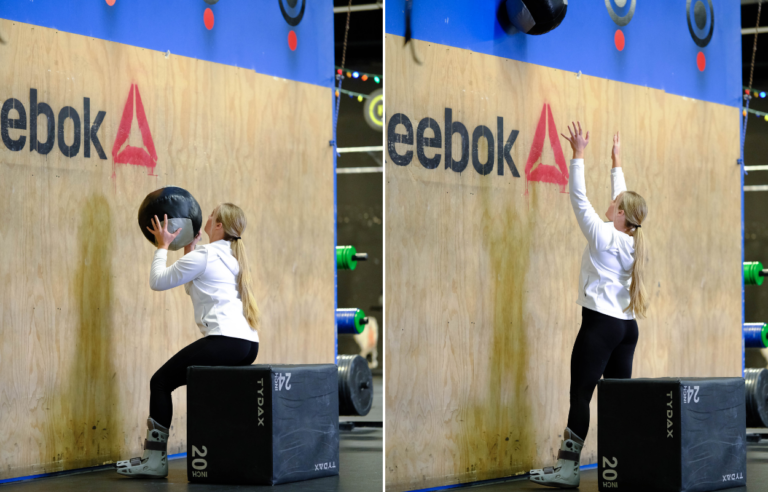
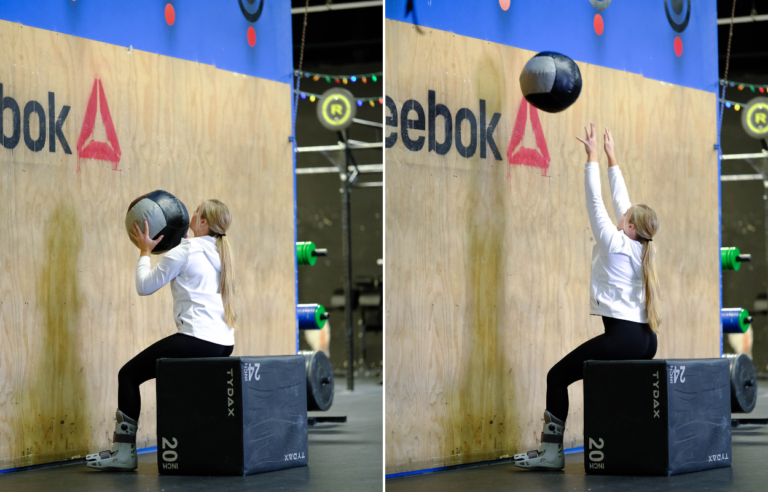
Photos by Abbey Nemeth
“One injury is not going to define you and one injury is not going to change your life,” Rockett says. “You have to keep going with your life. And you have to keep going with what you want to do safely.”
Injuries happen. Listen to your body, communicate with your doctor and coaches, and seek support from your community.
Injured? Don’t Skip the Gym